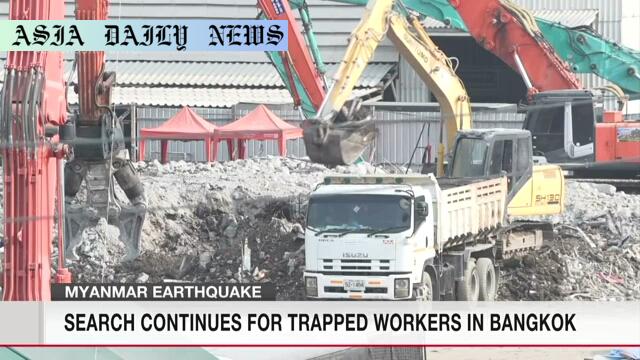Bangkok collapse: Search continues for over 70 trapped workers as investigation zeroes in on the cause of the high-rise disaster.

Continuing Search and Rescue Efforts in Bangkok
The tragic collapse of a 33-storey building under construction in Bangkok has claimed at least 15 lives, with more than 70 workers still unaccounted for. Officials and international rescue teams are tirelessly working to locate survivors trapped under the debris. This building collapse, triggered by a powerful earthquake originating in Myanmar last Friday, has left a scene of devastation and sorrow. Despite five days of relentless efforts, the chances of finding survivors diminish with each passing day as signs of life become harder to detect.
Rescue workers face immense challenges ranging from the unstable structure of the debris to time running out for trapped individuals. Advanced equipment such as ground-penetrating radar and canine units have been deployed to enhance the effectiveness of the operation. Families of victims anxiously await news as rescuers race against time to bring closure and justice to those impacted by the disaster.
Investigation Focuses on Construction Standards
The spotlight has now shifted to determining the cause of this tragic incident. The building was a collaborative project between a Thai company and a Chinese state-owned construction firm. Initial findings from Thailand’s industry ministry suggest that some of the steel used in the structure failed to meet the required strength standards. Officials have vowed to inspect other projects associated with this Chinese company, which include components of a high-speed railway planned to connect China and Thailand.
Public outrage has grown over the negligence that may have contributed to the collapse. Both Thai authorities and representatives of the Chinese firms involved have pledged to cooperate fully with investigations. Lessons from this tragedy are expected to influence stricter enforcement of building codes and ensure that safety is treated as a paramount priority in future construction projects.
Implications for Thai-Chinese Ventures
This disaster has broader implications for joint ventures in Thailand, particularly those involving Chinese companies. International partnerships must ensure strict adherence to safety protocols to avoid such devastating outcomes. While the Chinese embassy in Bangkok stated the intention to support investigations, closer scrutiny of ongoing projects is unavoidable to ensure compliance with international standards.
As Thailand navigates the crisis, the incident also exposes gaps in urban construction regulations and disaster mitigation strategies. For a nation prone to seismic activity, authorities must revisit earthquake resilience measures to avoid future tragedies. The building collapse serves as a wake-up call to prioritize safety over cost-cutting measures in ambitious infrastructure projects.
The Human Cost of Oversights
Beyond the structural and regulatory failures, this disaster highlights the human cost of oversight in construction projects. Stories of trapped workers, grieving families, and courageous rescue teams illustrate the profound toll of negligence. This incident is not just a tragedy for Bangkok but an alarm for all nations undertaking large-scale infrastructure projects worldwide.
The incident raises pressing questions about accountability, responsibility, and the consequences of prioritizing profits over people’s safety. As the investigation unfolds, justice for victims and measures to prevent such disasters in the future remain urgent priorities.
Commentary
The Importance of Accountability in Construction Standards
The collapsing of a 33-storey building in Bangkok serves as a tragic reminder of the critical importance of adhering to strict construction standards. This catastrophe, which has resulted in the loss of 15 lives and left over 70 individuals missing, highlights a significant lapse in safety protocols and sufficient oversight. When it comes to infrastructure, quality and compliance cannot be compromised, regardless of who undertakes the projects. It is disheartening to see that issues such as substandard steel have surfaced in initial findings, potentially making this situation preventable.
Implications for International Partnership Transparency
This incident casts a shadow over Thai-Chinese construction collaborations, with questions now arising around the robustness of international partnerships. Collaborative projects, particularly those with major stakeholders from different nations, warrant a meticulous approach to quality assurance and transparency. Both Thai authorities and Chinese contractors have a shared responsibility to show commitment toward uncovering the truth and rectifying flaws in processes moving forward. Accountability transcends borders and partnerships if mutual public trust and safety are to be preserved.
Lessons for Future Infrastructure Development
On a broader scale, this disaster is a wake-up call for nations globally. Infrastructure is the backbone of progress, but its strength lies in prioritizing quality over cost-cutting. Governments, contractors, and inspectors must learn lessons from such avoidable tragedies. This includes ensuring strict inspections, enforcing compliance with building codes, and putting public safety at the forefront of every project. Although this incident cannot be undone, the attention it garners can hopefully lead to reforms that prevent other nations from suffering similar heartbreaks.
Finally, while the focus remains on rescuing workers and grieving the lives lost, it is equally vital to channel collective efforts into preventing such devastating occurrences in the future. Lives and public trust depend on unwavering commitment to quality and accountability.


